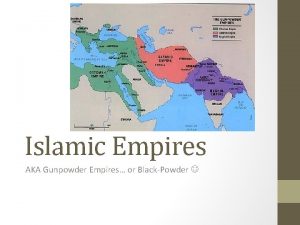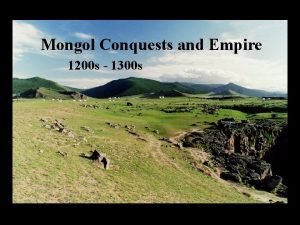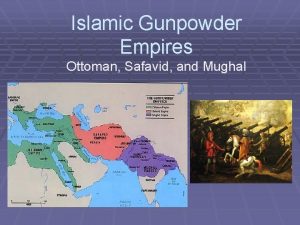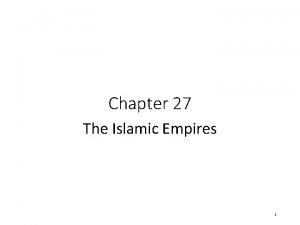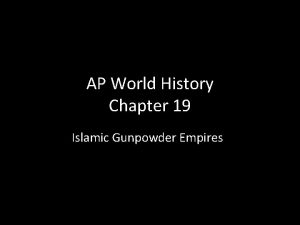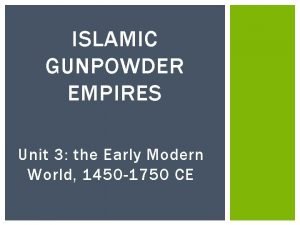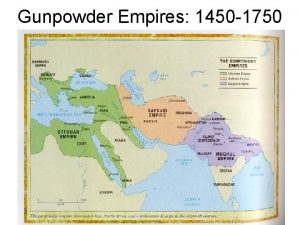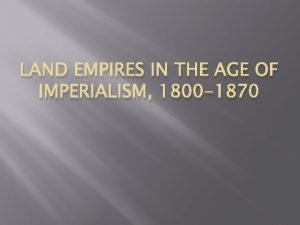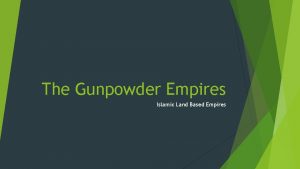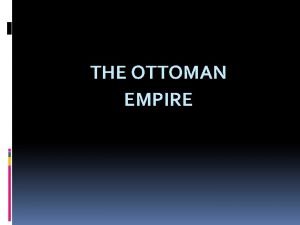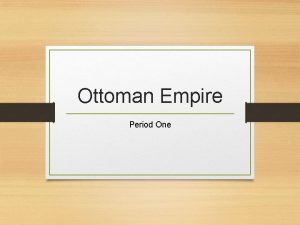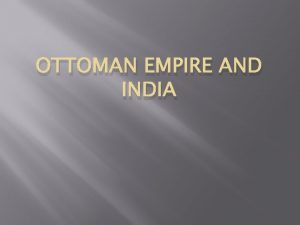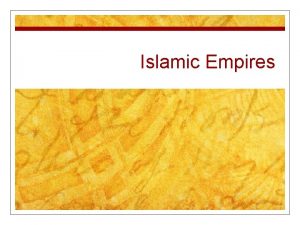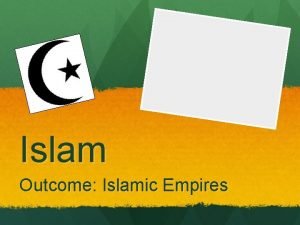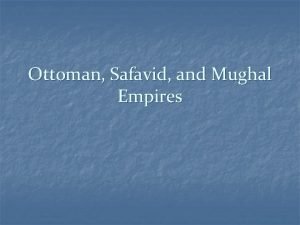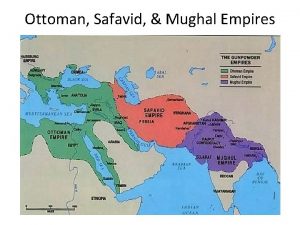Islamic Land Empires of the EarlyModern Era Ottoman













- Slides: 13

Islamic Land Empires of the Early-Modern Era Ottoman, Safavid, and Mughal

Ottoman Empire • Founded in Anatolia (modern-day Turkey), the Ottoman Empire began as a Turkish, Islamic sultanate, and began harnessing gunpowder weapons • In the 14 th century, the Ottoman Empire invaded the Balkans of Europe, marking the first Islamic invaders of Christian Europe since the 8 th century (Moors in Spain) • After surrounding the now small an struggling Byzantine Empire, the Ottoman Turks sacked and captured Constantinople in 1453 • After ending the Byzantine Empire, they expanded further into Eastern and Central Europe, as well as North Africa and Western Asia

Ottoman Expansion • The 16 th and 17 th centuries saw massive Ottoman expansion, particularly under Suleiman the Magnificent from 1520 -1566 • At this stage, Ottoman expansion seriously threatened central Europe, and the eastern-most parts of Catholic lands • While stopped at Vienna twice by allied Catholic states, the Ottoman Empire conquered and incorporated many languages and peoples • Additionally, the Ottoman Empire identified with and enforced Sunni Islam • It actively fought Shi’a Islam in it’s off-and-on 200 -year struggle against the Persian Safavid Empire, which also began to use gunpowder weapons

Ottoman Domestic Policies • To fund its empire, the Ottoman Empire focused mostly on heavy taxation from its conquered areas, and agriculture • While the Ottoman Empire maintained protection of non-Muslims, it still maintained the dhimmis status and jizya of other Islamic empires • The sultans of the O. E. also funded miniature paintings of sultans as grand leaders, and going about their regular days, distributing them to demonstrate their power and influence, just as Louis XIV did with Versailles • While it was successful in expanding in the 16 th and 17 th centuries, its conquests and extensive wars with Europeans and Persians took a toll • Particularly in Europe, the Ottoman Empire struggled to control the Balkan region, home to mostly Eastern Orthodox Slavic peoples

Ottoman Domestic Policies Cont. • Not only did they struggle to control the Slavic Christians of the Balkans, but the overtaxed agricultural Turkish elites also posed a problem with threats of rebellion and resistance to paying high taxes • To keep the Christians and Turkish elites in check, the Ottoman Empire began the devshirme, also known as the ‘blood tax’ • The devshirme was the removal of Christian boys at age 8 from Christian nobles and elites, and putting them into military service • Known as janissaries, these Christian boys were trained to be loyal to and fight for only the sultan, forced to convert to Islam, and castrated to avoid distraction • This provided the sultan with a loyal, elite fighting force to keep the Christians in the Balkans and Turkish elites within the Ottoman Empire in check by force

Max O. E. Extension

Safavid Empire: 1506 -1736 • When the Il-Khanate faded, and the Mongol and Turkic invaders had been chased out, a native (and last) Persian Empire re-emerged in 1506 • It re-established Persia as a major economic and political power for the first time since Rome, and adopted modern, gunpowder weapons • What the Safavid Empire is most know for are twofold: • It’s official establishment of Shi’a Islam, and the largest Shi’a state in history • The establishment of a Persian identity and ground laying for modern-day Iran

Ottoman-Safavid Conflicts • Ill placed, Persians had always faced empires on multiple sides, and routinely struggled to maintain their empire on multiple fronts • While conflict with the Mughals to the east was minimal, the conflicts against the Ottoman Turks (Sunni Islam) spanned more than 200 years • These conflicts took a massive toll on both empires, and were embodied as a state vs. state conflict of the early Sunni/Shi’a Islam split • While the Ottoman Empire would outlast the Safavid, they were responsible for spreading and enforcing Shia Islam • Ruled by a shah, the Safavid empire forced Shi’a Islam as its state religion, as its leader claimed Divine political and spiritual power, converting the peoples of modern-day Iran, Georgia, Azerbaijan, the Middle East, Pakistan, Central Asia, and Mesopotamia to Shi’a Islam

Max Safavid Extension

Mughal Empire (1526 -1857) • The Mughals (mow-guls) were a group of Turco-Mongol invaders from the former khanates of Chagatai and the Il-Khanate • While they defeated and overtook the Delhi Sultanate in 1526, the invaders were also officially Muslim • A key difference between the Mughal rulers and their Delhi predecessors was their tolerance for the local diversity of India • Coming from Persian, Turkic, and Mongol race and culture, the Mughal emperors were used to diversity and syncretization • This made them far more successful than the intolerant and iconoclastic Muslim Delhi Sultanate

Mughal Control of India • By 1555, the greatest Mughal ruler, Akbar the Great, had either conquered or ingeniously gathered the support of locals • The Hindi and Sikh kingdoms that had opposed and weakened the Delhi Sultanate were much more willing to comply with the Mughals • Mughals allowed local ethnic rulers to keep their power, as long as they remained loyal and paid their taxes • They were also made a part of the much more organized central gov. , and local princes—called zamindars—were rewarded for loyalty • Zamindars—whatever their ethnicity—functioned as governors of the region, and were responsible for collecting taxes for the central gov. , and participating in the military

Mughal Prosperity • This organization and relative cooperation amongst the diverse Indian subcontinent brought on the last of India’s golden ages • During the 16 th and 17 th centuries, the Mughal Empire was the #1 producer of manufactured goods, most notably cotton textiles • They also harnessed gunpowder weapons, just as their Islamic counterparts in the Ottoman and Safavid Empires • Embracing their diversity, and enjoying wealth and economic prosperity, the Mughals built elaborate temples and other monuments, as well as massive, elaborate gunpowder forts • One such famous example is the Taj Mahal, influenced by Persian, Turkic, and Hindu Indian culture

Mughal Empire Greatest Extent 17 th century
 Maritime and land-based empires similarities
Maritime and land-based empires similarities How did the ottoman safavid and mughal empires arise
How did the ottoman safavid and mughal empires arise Ottoman, safavid, and mughal empires venn diagram
Ottoman, safavid, and mughal empires venn diagram Islamic gunpowder empires webquest
Islamic gunpowder empires webquest Islamic gunpowder empires ottomans safavids and mughals
Islamic gunpowder empires ottomans safavids and mughals Chapter 27 the islamic empires
Chapter 27 the islamic empires Chapter 27 the islamic empires
Chapter 27 the islamic empires Chapter 19 islamic gunpowder empires
Chapter 19 islamic gunpowder empires How big was the islamic empire
How big was the islamic empire Land based empires 1450 to 1750
Land based empires 1450 to 1750 Land empires in the age of imperialism
Land empires in the age of imperialism Identify the landform
Identify the landform What are landforms
What are landforms Era uma estrela tão alta era uma estrela tão fria
Era uma estrela tão alta era uma estrela tão fria

